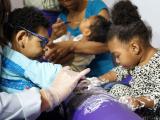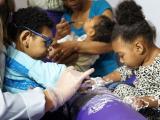With the Olympic and Paralympic games in Rio de Janeiro just months away, the World Health Organization (WHO) and the Pan American Health Organization (PAHO) today released a set of steps that athletes and visitors can take to protect themselves from Zika virus.
In other developments, Chinese researchers reported additional findings from infected fetal mice and the WHO and US Centers for Disease Control and Prevention (CDC) provided big-picture views with weekly updates.
Olympics advice
In the Olympics advice, WHO and PAHO still urge pregnant women to avoid areas of active Zika transmission, which include the host city of Rio de Janeiro. Though the games will take place during Brazil's winter season when the mosquitoes that carry Zika and other viruses are less active, the agencies recommend that visitors follow WHO and home-country travel advice and consult a health worker before departing.
Other steps include wearing insect repellent and light-colored clothing that covers as much of the body as possible and practicing safe sex or abstaining for at least 4 weeks after returning from the games, especially when Zika symptoms are or were present.
Athletes and visitors should select air-conditioned accommodations, which are more likely to keep mosquitoes from entering, and to avoid visiting crowded cities and towns with poor sanitation and lack of running water.
The WHO and PAHO have been asked to make public health recommendations to Brazil's government and the International Olympic Committee on ways to further cut the Zika risk, including measures to reduce Aedes mosquito populations.
Fetal mouse study finds early, late damage
A research team from China yesterday reported more observations in Zika-infected fetal mice, joining two similar studies published the same day, all connecting the virus to extensive damage in developing brains. The findings appear in an early online edition of Cell Stem Cell.
The team injected the virus directly into the fetal mouse brains.
Zhiheng Xu, MD, PhD, a study coauthor based at the Chinese Academy of Sciences in Beijing, said yesterday in a Cell Press media release that the most surprising finding was that early on the virus mainly infected neural progenitor cells, but neurons weren't affected until later—5 days after infection—when viral levels were high.
He said almost all cell death was found in neurons. "This indicates that neurons, but not neural progenitor cells, are prone to induced cell death by the Zika virus," Xu added.
In their mouse model, the researchers saw that fetal mouse brains shrunk as viral load increased alongside an intense immune response. The mice survived to birth but were eaten by their mothers, which the team said often happens when mouse babies are sick. For the next round of experiments, the team will use a lower Zika virus dose to see if the baby mice survive. Chinese researchers are also trying to identify any drugs that could reverse the Zika-related microcephaly process.
Cheng-Feng Qin, PhD, a study coauthor and virologist at Beijing Institute of Microbiology and Epidemiology, said in the press release, "Mice are not humans, and we need be careful when translating our findings into human disease."
WHO, CDC updates
In its weekly update today, the WHO said it still sees no overall decline in the outbreak, though some countries or parts of some countries are reporting ebbing numbers. The agency said the virus continues to spread, with Grenada as the most recent location to report local transmission.
Among other new details in today's report, the WHO said three suspected cases of microcephaly or other neurologic abnormalities are under investigation in Venezuela, Honduras, and Spain.
Incident managers from the six WHO regions who met last week to share lessons learned and discuss the next response steps, and a draft of a strategic framework for the second half of 2016 will be shared with partners in the middle of May, with a mid June target for finalization.
The CDC in its weekly update on cases in the territories and states said that as of yesterday 40 more local Zika infections were reported in the affected territories, raising the total to 698, most of them in Puerto Rico. Six more illnesses were reported in pregnant residents of the territories, raising that number of 65.
On the mainland, 31 more travel-related cases were reported, lifting the tally to 503, the CDC said. Four more Zika infections have been reported in pregnant travelers, boosting that number to 48.
Other developments
- US Senate negotiators today announced they have reached a $1.1 billion compromise agreement that falls short of the $1.9 billion requested by President Barack Obama, the Associated Press reported. Sen. Patty Murray, D-Wash., said she prefers Obama's proposal but reached a concession with Sen. Roy Blunt, R-Mo., on the lower funding level, which is likely to be added to a bill next week.
- The CDC today added Grenada to its level 2 travel advisory for pregnant women and those considering getting pregnant.
- Brazil's health ministry yesterday reported 95 more suspected microcephaly, raising the number that are still under investigation to 3,433, according to a statement translated and posted by Avian Flu Diary, an infectious disease news blog. The health ministry has confirmed 55 of the earlier suspected cases and ruled out 187 of them, putting the total number of confirmed cases at 1,326.
- Researchers from Belgium and Brazil who developed a cell-based assay to identify potential drugs that inhibit Zika virus found that the viral polymerase inhibitor 7DMA blocks replication. The team reported its findings May 10 in PLoS Neglected Tropical Diseases. In experimentally infected immune-compromised mice, 7DMA reduced viremia and delayed virus-induced morbidity and mortality.
See also:
May 12 WHO-PAHO Olympics recommendations
May 11 Cell Stem Cell abstract
May 11 Cell Press media release
May 12 WHO Zika situation report
May 12 CDC Zika update





















